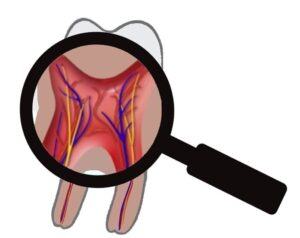Sometimes, a tooth with recent dental work can suddenly and unexpectedly develop a full-blown toothache.
If you recently had a crown or a filling placed and now you’ve received the unwelcome news that you need a root canal, you might be wondering why this happened.
Fortunately, most of the time it does not happen. But, when it happens to you, statistics don’t matter.
From a dentist’s perspective, this is a tough situation. Patients aren’t very happy with us. They sometimes suspect that we did something wrong. That’s understandable. After all, the tooth felt perfectly fine until we worked on it!


It’s All About the Pulp
The explanation for your toothache lies in the microbiological world of your tooth’s pulp.
While your pulp may not have been symptomatic before your dental work, we now know it was not healthy. It had a low-grade infection or irreversible pulpitis. Your recent dental work simply exacerbated the pre-existing infection.
Cause of Low-Grade Pulp Infection
A healthy, structurally sound tooth is tough for bacteria to penetrate. But bacteria are pretty darn small. Occasionally they will find their way into the pulp. If your pulp is healthy, it can handle it. It can easily fend off the few invaders that make it in.
But, if the tooth accumulates defects over the years, like cavities, cracks, or leaky fillings – the same kind of defects that compel the need for dental work in the first place – those defects can allow more bacteria and other irritants into the pulp.
Damaged teeth have lost some of their protective outer enamel. The dentin layer underneath is softer and more porous than enamel. Bacteria can navigate it more easily. If the tooth has chronic gingivitis, the bacteria residing in the periodontal pocket can also get into the pulp. They can travel inside the tooth through the porous root surface.
Over time, more bacteria and irritants accumulate in the pulp and establish a chronic, low-grade infection. Some pulps with a low-grade infection have mild inflammation and mild symptoms – like pain on chewing or cold sensitivity. But nothing alarming. Others have no symptoms at all.
On the day of your filling or crown appointment, neither you nor your dentist is aware that your pulp is infected and too weak to withstand the procedure.
Why Does Dental Work Blow Up a Pre-Existing Pulp Infection?
Many pulp-dwelling bacteria can survive with little to no oxygen. These bacteria would like to have oxygen, but they can survive without it. They’re called facultative anaerobes.
When a tooth is reshaped for the filling or crown, it allows an influx of oxygen to these bacteria. The oxygen exposure fuels the bacterial colony’s growth. And, as the infection grows, so does pain. The pulp becomes very inflamed and filled with gases and fluids. Since the pulp is trapped in the tooth, it has nowhere to expand.
The inflammation and pressure cause excruciating pain. Sometimes the gases and fluids will start to leak out the end of the root and cause your tooth to lift up – a classic abscess. That’s a double whammy – your tooth is infected and it’s biting too heavily. Ouch! This process can happen fairly quickly – sometimes just a few days to a few weeks after the dental work.
Treatment for Irreversible Pulpitis
The only way to resolve your pulp infection is to either do a root canal or extract your tooth. Many patients ask for antibiotics. But, antibiotics are not the solution. They will never cure an infected pulp.
However, sometimes it is necessary to take antibiotics to reduce the infection prior to treatment. Although the antibiotic can reach the tissues around the tooth, it doesn’t penetrate the pulp directly. Consequently, the infection is bound to resurge without definitive intervention.
It’s important to get definitive treatment as soon as possible to resolve your infection. Tooth infections have been known to spread to other parts of the body and cause life-threatening sepsis. It’s rare, but it’s not something to mess around with!
Will You Need a New Crown?
If you already have a crown on your tooth, you don’t necessarily need to replace it. To access your pulp and do the root canal, your dentist will need to drill a hole in your new crown. A filling can usually be placed in this access hole later.
If you do not already have a crown on the tooth, you might need one after your root canal. It’s standard-of-care to place a crown on any back tooth (any tooth behind the canine) after a root canal. Multi-cusped, root-canal-treated teeth are more subject to fracture. A crown will cover and protect the tooth from fracture.
Irreversible Pulpitis Months or Years After Dental Work
In some cases, a painful pulp infection can develop many months or years after dental work. A pulp can weaken and die slowly and painlessly over time. It’s not just cavities and dental work that can damage a pulp. A pulp can be weakened by erosion, cracks, trauma, and chronic heavy forces like grinding. The mouth is a tough neighborhood!
The pulp can die slowly without triggering any noticeable symptoms. However, once the pulp is dead, it is more vulnerable to developing a large and painful infection. The trouble is, you just never know when it will strike. Hopefully not on a Friday night!
Despite these possible complications after dental work, they do not usually happen. Reasonably healthy pulps should withstand most routine dental work. When we place very deep fillings or we suspect that your pulp is not healthy, we’ll warn you that there’s a greater chance that you could develop a toothache and need a root canal later.
Don’t Kick Yourself – You Needed the Work
If, unbeknownst to you or your dentist, your pulp was not healthy before you had the work done, don’t kick yourself for doing it. It was almost assuredly necessary. Most of the time the problem is solvable with a root canal. If you didn’t do the work, the infection would have caught up with you eventually. The dental work just accelerated the process. But, it’s no fun when it happens!
I hope you now understand why a painful toothache and the diagnosis of irreversible pulpitis can develop after dental work. Sometimes it happens shortly after the work was done. Other times it can strike months to years later. It all depends on what is happening in that mysterious hidden chamber inside the tooth – the pulp.
Please let me know if you have any questions by posting in the comment section below!


Incredibly helpful gave me guidance I need
Thank you, Doug!
Thank you! For this post. I did have this happen to me in the past. I have to admit that I did blame my dentist. I never said anything to him. But I wondered if he cause the root canal? I still trusted him and was a patient until he retired. Thus would have been so good to know before the procedure. This would be a great site to share with dental patients. Thank you!